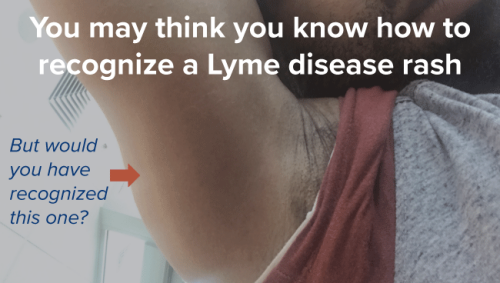IMPORTANT RASH FEATURES
Lyme disease rash is:
- Sometimes, but not usually, a ring within a ring Bull’s-eye rash appearance
- Often mistaken for a spider bite but is not a spider bite
- Not always present. Not everyone has a rash.
- More difficult to discern in darker-skinned indivduals.
Characteristics of Lyme disease rash:
- Large expanding red round rash
- Grows to greater than 2” in diameter over days or weeks
- Bull’s eye appearance of rash only appears in the minority of Lyme disease cases
- Uniformly red in the majority of cases
A leading cause of misdiagnosis is the failure to recognize a Lyme disease rash when it is present.
Research at our Center showed that when a rash was the first sign of Lyme disease detected, individuals were more likely to be treated earlier than those who were treated based on symptom presentation first.
Sometimes viral-like symptoms precede a rash and are the first initial signs of early Lyme disease. Recognizing these early Lyme disease symptoms can be key to an early diagnosis, especially since not everyone develops a discernable Lyme disease rash.
There is a need for improved diagnostics as well as physician awareness of the varied manifestations of early Lyme disease.

Misdiagnosis is particularly a problem in darker-skinned individuals.
Research at our Center showed that Black patients with Lyme disease are more likely to be diagnosed later and have more advanced stages of disease at the time of diagnosis than White patients.
Improved physician and community education is needed to address racial disparities in Lyme disease diagnosis and treatment.
- Education is lacking in the identification of the EM rash of early Lyme disease for patients with darker skin tones.
- Delays in diagnosis and treatment increase the risk of infection progressing to more severe symptoms including severe fatigue, arthritis, heart problems. cognitive impairment, and neurologic problems.
HOW CAN YOU HELP?
We are working to broaden the representation of Lyme disease rash photos for educational purposes.
If you have pictures of a Lyme disease rash on a darker-skinned individual please help us by calling 410-616-7596 to discuss. -Thank you!
Research in our Center aims to improve the recognition of a Lyme disease rash:
- Research shows the presenting characteristics of the Lyme disease rash vary by age, sex, duration, and body location.
- A case study shows Lyme disease rash may be harder to discern in people of color.
- Research confirms the higher risk of misdiagnosis in darker-skinned individuals and that delays in diagnosis increase the risk of more severe symptoms.
- Research shows that the initial presentation of a rash and symptoms affects time to treatment.
- Our Center is working on AI methods to improve early diagnosis of the Lyme disease rash.
- Johns Hopkins rash poster
- CDC rash poster
Available blood tests are antibody-based for Lyme disease and do not accurately diagnose Lyme disease in the first few weeks of infection. False negative tests are a problem in acute Lyme disease. Therefore, early Lyme disease is a clinical diagnosis. Recognizing signs, such as the rash, and flu-like symptoms such as fever, achiness, extreme fatigue, severe headache or neckache can be vital to receiving appropriate early treatment.
Suspicious Rash or Flu-Like Symptoms?
If you have a suspicious expanding red circular rash and/or flu-like symptoms such as fever, achiness, extreme fatigue, severe headache or neckache, this could be acute Lyme disease. Please seek medical care immediately.


